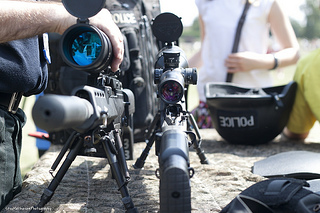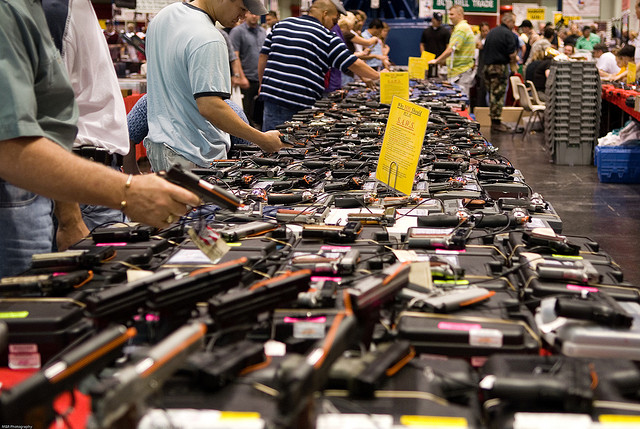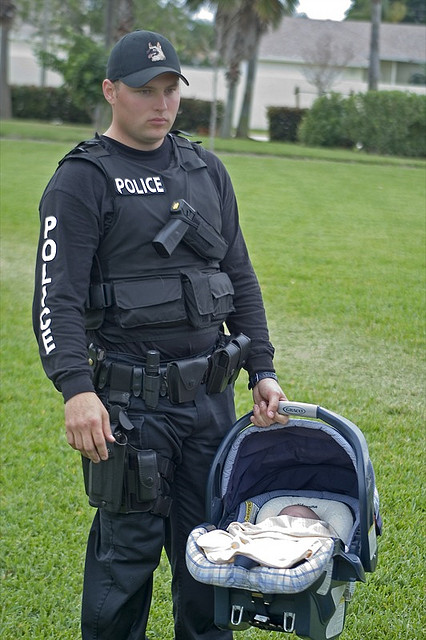Who Do You Protect?: Police Brutality and Gun Control

 In the midst of all the hoopla, rhetoric, and controversy that’s been flying around for the past couple weeks that was sparked by Ferguson and fueled by various other police-related tragedies, I’m here to talk about guns.
In the midst of all the hoopla, rhetoric, and controversy that’s been flying around for the past couple weeks that was sparked by Ferguson and fueled by various other police-related tragedies, I’m here to talk about guns.
Now you might be asking yourself why I’m not writing about race or more specifically, racism in America and my answer is this: I want to talk about problems that have realistic solutions. When I say realistic solutions, I mean actions that the government can immediately take that will create immediate results. Is racism an issue? Yes. Is it the government’s job to end racism? Technically, no. That’s our job as a society and hopefully morally sound people, but the government can help. For instance they can have schools try to teach kids not to bully each other and to treat each other with respect. Obviously success is not guaranteed. But the point I’m trying to make is that the government can’t make anyone stop being racist. And if they could I’d probably think about fleeing the country, because mind control is not cool.
So back to the topic at hand: guns, and more specifically the police who wield guns. The reason people fear guns, or at least the reason why I personally am afraid of picking up a gun, is because of their potential to harm. By themselves, they’re a harmless hunk of metal but when you add a finger to the trigger, their potential to harm is exponentially higher.
Why then, do we let people, even if they are police, roam through civilian areas with these weapons? How can we be expected to feel safe around the police or even trust them when the balance of power is so obviously skewed?
I’m not saying that the police shouldn’t be armed, because they should have a way to protect themselves. What I am saying is that having police officers armed with guns and patrolling the halls of a public school in the middle of the suburbs is a bit of an overkill. And yes, I’m speaking from personal experience.
In the UK the majority of British police officers do not carry firearms, and as a result, the number of people fatally shot in 2012 was zero. Compared to the 409 Americans killed by police in 2012, the UK has created a much safer environment, at least in terms of gun control. Because criminals in Britain rarely have guns, their police officers don’t need to carry them. This is unfortunately not true in the US. In the US, gun control is a hot topic, with many people pushing for stricter laws against ready access to firearms. But in the mean time, police are wielding guns against both armed criminals and the majority of unarmed civilians alike.
 The mission statement of the New York Police Department is to enforce the laws, preserve the peace, reduce fear, and provide for a safe environment. While requiring a gun in order to fight crime is understandable, needing a gun in order to preserve peace and reduce fear is not. There should be a clear distinction between fighting crime and creating a safe environment. To fight crime is to court hostile situations, creating a safe environment is to work with your normal everyday civilians.
The mission statement of the New York Police Department is to enforce the laws, preserve the peace, reduce fear, and provide for a safe environment. While requiring a gun in order to fight crime is understandable, needing a gun in order to preserve peace and reduce fear is not. There should be a clear distinction between fighting crime and creating a safe environment. To fight crime is to court hostile situations, creating a safe environment is to work with your normal everyday civilians.
In some ways, many police departments already have a vague distinction between the two jobs. SWAT teams are specifically intended and trained for high risk operations but regular police officers are expected to do both. After repeatedly responding to hostile situations where bullets are flying and they’re putting their lives at risk, they’re expected to be able to switch gears and go back to working with civilians. It makes sense then, that police will sometimes respond with unnecessary force.
That’s why there should be a clear separation of labor: those who fight crime and those who create a safe environment. Leave the gun slinging to those who are specially trained for it while the regular police have the local, grass-roots work of managing traffic, herding confused civilians, and reassuring people that everything is under control. This separation of labor insures that those who carry lethal firearms have minimal exposure to the public, and therefore less of a chance to come into conflict with a civilian. Furthermore, this means that the police who interact with the public should not need to carry heavy firearms.
A separation of labor will also ensure a greater specialization of skills. Those who fight crime will focus on taking down criminals while defending themselves and those who work with the public will focus on keeping the peace and protecting others. This will hopefully prevent the police who work with the public from panicking and shooting a boy with a toy gun or from using illegal chokeholds on a man with asthma. While these tragic incidents are also the products of the deeply ingrained social and racial prejudices which color people’s reactions to the situations they encounter in the field, better training can only help counterbalance the negative impact of racial profiling.
There should be a direct correlation between the potential harm that police pose and the potential threat that they face in the field, as well as a clearer separation of labor. These are both things that the government can and should do to protect the populations they are meant to serve.
Images from Flickr Creative Commons.
